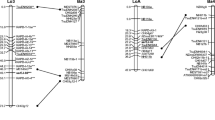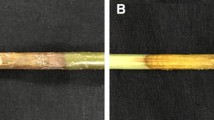Abstract
Linkage maps for the apple cultivars ‘Prima’ and ‘Fiesta’ were constructed using RFLP, RAPD, isozyme, AFLP, SCAR and microsatellite markers in a ‘Prima’בFiesta’ progeny of 152 individuals. Seventeen linkage groups, putatively corresponding to the seventeen haploid apple chromosomes, were obtained for each parent. These maps were aligned using 67 multi-allelic markers that were heterozygous in both parents. A large number of duplicate RFLP loci was observed and, in several instances, linked RFLP markers in one linkage group showed corresponding linkage in another linkage group. Distorted segregation was observed mainly in two regions of the genome, especially in the male parent alleles. Map positions were provided for resistance genes to scab and rosy leaf curling aphid (Vf and Sd 1, respectively) for the fruit acidity gene Ma and for the self-incompatibility locus S. The high marker density and large number of mapped codominant RFLPs and some microsatellite markers make this map an ideal reference map for use in other progenies also and a valuable tool for the mapping of quantitative trait loci.
Similar content being viewed by others
Author information
Authors and Affiliations
Additional information
Received: 17 November 1997 / Accepted: 9 December 1997
Rights and permissions
About this article
Cite this article
Maliepaard, C., Alston, F., van Arkel, G. et al. Aligning male and female linkage maps of apple (Malus pumila Mill.) using multi-allelic markers. Theor Appl Genet 97, 60–73 (1998). https://doi.org/10.1007/s001220050867
Issue Date:
DOI: https://doi.org/10.1007/s001220050867




